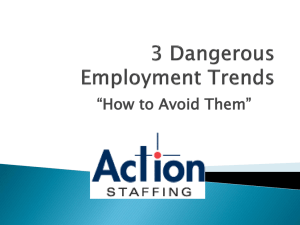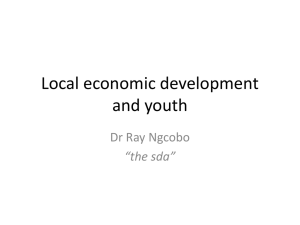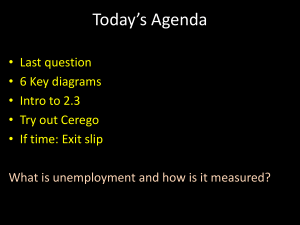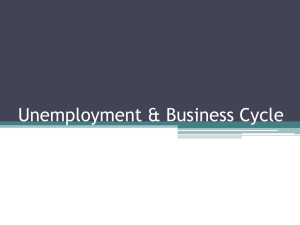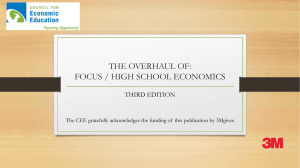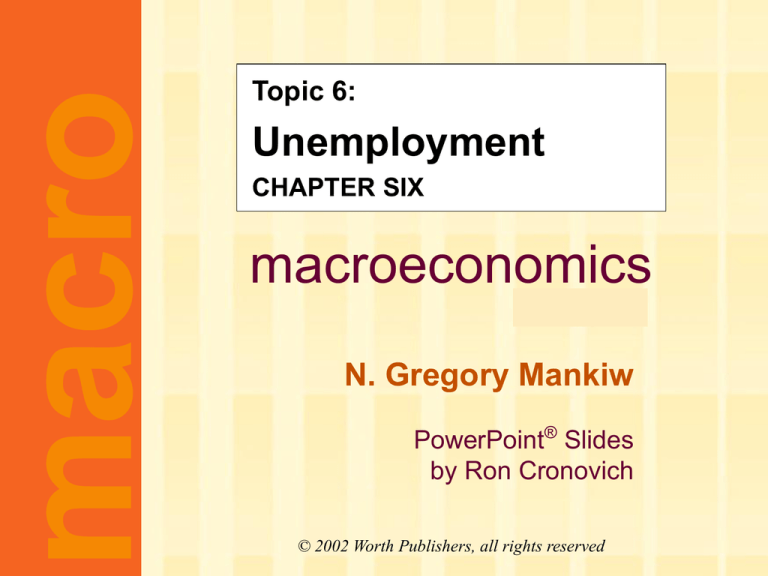
macro
Topic 6:
Unemployment
CHAPTER SIX
macroeconomics
fifth edition
N. Gregory Mankiw
PowerPoint® Slides
by Ron Cronovich
© 2002 Worth Publishers, all rights reserved
Chapter objectives
The natural rate of unemployment:
what it means
what causes it
understanding its behavior in the real
world
CHAPTER 6
Unemployment
slide 1
Natural Rate of Unemployment
Natural rate of unemployment:
the average rate of unemployment around
which the economy fluctuates.
In a recession, the actual unemployment rate
rises above the natural rate.
In a boom, the actual unemployment rate falls
below the natural rate.
CHAPTER 6
Unemployment
U.S. Unemployment, 1958-2002
11
Percent of labor force
10
9
8
7
6
5
4
3
2
1955
1960
1965
1970
1975
Unemployment rate
CHAPTER 6
Unemployment
1980
1985
1990
1995
2000
Natural rate of unemployment
slide 3
A first model of the natural rate
Notation:
L = # of workers in labor force
E = # of employed workers
U = # of unemployed
U/L = unemployment rate
CHAPTER 6
Unemployment
slide 4
Assumptions:
1. L is exogenously fixed.
2. During any given month,
s = fraction of employed workers
that become separated from their jobs,
f = fraction of unemployed workers
that find jobs.
s = rate of job separations
f = rate of job finding
(both exogenous)
CHAPTER 6
Unemployment
slide 5
The transitions between
employment and unemployment
s E
Employed
Unemployed
f U
CHAPTER 6
Unemployment
slide 6
The steady state condition
Definition: the labor market is in
steady state, or long-run equilibrium,
if the unemployment rate is constant.
The steady-state condition is:
s E = f U
# of employed
people who
lose or leave
their jobs
CHAPTER 6
# of unemployed
people who find
jobs
Unemployment
slide 7
Solving for the “equilibrium” U rate
f U
= s E
= s (L –U )
= s L – s U
Solve for U/L:
(f + s)U = s L
so,
CHAPTER 6
U
s
L s f
Unemployment
slide 8
Example:
Each month, 1% of employed workers lose
their jobs (s = 0.01)
Each month, 19% of unemployed workers
find jobs (f = 0.19)
Find the natural rate of unemployment:
U
s
0.01
0.05, or 5%
L s f
0.01 0.19
CHAPTER 6
Unemployment
slide 9
policy implication
A policy that aims to reduce the natural
rate of unemployment will succeed only
if it lowers s or increases f.
CHAPTER 6
Unemployment
slide 10
Why is there unemployment?
If job finding were instantaneous (f = 1),
then all spells of unemployment would be
brief, and the natural rate would be
near zero.
There are two reasons why f < 1:
1. job search
2. wage rigidity
CHAPTER 6
Unemployment
slide 11
Job Search & Frictional Unemployment
frictional unemployment: caused by the
time it takes workers to search for a job
occurs even when wages are flexible and
there are enough jobs to go around
occurs because
workers have different abilities, preferences
jobs have different skill requirements
geographic mobility of workers not
instantaneous
flow of information about vacancies and job
candidates is imperfect
CHAPTER 6
Unemployment
slide 12
Sectoral shifts
def: changes in the composition of demand
among industries or regions
example: Technological change
increases demand for computer repair persons,
decreases demand for typewriter repair persons
example: A new international trade agreement
causes greater demand for workers in the export
sectors and less demand for workers in importcompeting sectors.
It takes time for workers to change sectors,
so sectoral shifts cause frictional unemployment.
CHAPTER 6
Unemployment
slide 13
Industry shares in U.S. GDP, 1960
57.9%
Agriculture
Manufacturing
Other industry
Services
9.9%
4.2%
28.0%
CHAPTER 6
Unemployment
slide 14
Industry shares in U.S. GDP, 1997
72.0%
Agriculture
Manufacturing
Other industry
Services
8.5%
17.8%
CHAPTER 6
1.7%
Unemployment
slide 15
Sectoral shifts abound
more examples:
Late 1800s: decline of agriculture, increase in
manufacturing
Late 1900s: relative decline of manufacturing,
increase in service sector
1970s energy crisis caused a shift in demand
away from huge gas guzzlers toward smaller
cars.
In our dynamic economy, smaller (though still
significant) sectoral shifts occur frequently,
contributing to frictional unemployment.
CHAPTER 6
Unemployment
slide 16
Public Policy and Job Search
Govt programs affecting unemployment
Govt employment agencies:
disseminate info about job openings to better
match workers & jobs
Public job training programs:
help workers displaced from declining
industries get skills needed for jobs in
growing industries
CHAPTER 6
Unemployment
Unemployment insurance (UI)
UI pays part of a worker’s former wages for a
limited time after losing his/her job.
UI increases search unemployment, because it:
– reduces the opportunity cost of being
unemployed
– reduces the urgency of finding work
– hence, reduces f
Studies: The longer a worker is eligible for UI,
the longer the duration of the average spell of
unemployment.
CHAPTER 6
Unemployment
Benefits of UI
By allowing workers more time to search,
UI may lead to better matches between
jobs and workers,
which would lead to greater productivity
and higher incomes.
CHAPTER 6
Unemployment
Why is there unemployment?
U
s
The natural rate of unemployment:
L s f
There are two reasons why f < 1:
DONE
1. job search
Next 2. wage rigidity
CHAPTER 6
Unemployment
slide 20
Unemployment from real wage rigidity
If the real
wage is
stuck above
the eq’m
level, then
there aren’t
enough jobs
to go
around.
Real
wage
Supply
Unemployment
Rigid
real
wage
Demand
Labor
Amount of
labor hired
CHAPTER 6
Unemployment
Amount of labor
willing to work
slide 21
Unemployment from real wage rigidity
If the real
wage is
stuck above
the eq’m
level, then
there aren’t
enough jobs
to go
around.
CHAPTER 6
Then, firms must ration the
scarce jobs among workers.
Structural unemployment:
the unemployment resulting
from real wage rigidity and
job rationing.
Unemployment
slide 22
Reasons for wage rigidity
1.
Minimum wage laws
2.
Labor unions
3.
Efficiency wages (employers offer high wage
as incentive for worker productivity and loyalty)
CHAPTER 6
Unemployment
slide 23
The minimum wage
The minimum wage is well below the eq’m
wage for most workers, so it cannot explain
the majority of natural rate unemployment.
However, the minimum wage may exceed
the eq’m wage of unskilled workers,
especially teenagers.
If so, then we would expect that increases in
the minimum wage would increase
unemployment among these groups.
CHAPTER 6
Unemployment
slide 24
The minimum wage in the real world:
In Sept 1996, the minimum wage was raised
from $4.25 to $4.75. Here’s what happened:
Unemployment rates, before & after
3rd Q 1996
1st Q 1997
Teenagers
16.6%
17.0%
Single
mothers
8.5%
9.1%
All workers
5.3%
5.3%
Other studies: A 10% increase in the minimum
wage increases teenage unemployment by 1-3%.
CHAPTER 6
Unemployment
slide 25
Labor unions
Unions exercise monopoly power to secure
higher wages for their members.
When the union wage exceeds the eq’m
wage, unemployment results.
Employed union workers are insiders
whose interest is to keep wages high.
Unemployed non-union workers are
outsiders and would prefer wages to be
lower (so that labor demand would be high
enough for them to get jobs).
CHAPTER 6
Unemployment
slide 26
Union membership and wage ratios by industry, 2001
(1000s)
U % of
total
RBU %
of total
wage
ratio
531
12.3%
12.9%
103.4
construction
6,881
18.4
19.0
151.0
manufacturing
18,149
14.6
15.5
105.9
transportation
4,441
24.1
25.4
127.8
comm. and pub util
2,981
22.6
23.7
104.2
wholesale trade
4,540
5.5
5.9
105.8
retail trade
20,505
4.5
5.0
117.8
fin, insu, and real est
7,648
2.1
2.8
90.1
services
34,261
5.9
6.8
103.3
government
19,155
37.4
41.8
121.1
119,092
13.6%
15.0%
118.0
industry
mining
all
# employed
RBU = nonunion workers represented by a union
wage ratio = 100(union + RBU wage)/(nonunion wage)
slide 27
Efficiency Wage Theory
Theories in which high wages increase worker
productivity:
– attract higher quality job applicants
– increase worker effort and reduce “shirking”
– reduce turnover, which is costly
– improve health of workers
(in developing countries)
The increased productivity justifies the cost of
paying above-equilibrium wages.
The result: unemployment
CHAPTER 6
Unemployment
slide 28
The duration of U.S. unemployment,
average over 1993-2002
# of weeks
unemployed
# of unemployed
persons as % of
total # of
unemployed
amount of time
these workers spent
unemployed
as % of total time
all workers spent
unemployed
1-4
39%
6.5%
5-14
31%
20.5%
15 or more
30%
73.0%
CHAPTER 6
Unemployment
slide 29
The duration of unemployment
The data:
More spells of unemployment are short-term
than medium-term or long-term.
Yet, most of the total time spent unemployed
is attributable to the long-term unemployed.
This long-term unemployment is probably
structural and/or due to sectoral shifts among
vastly different industries.
Knowing this is important because it can help
us craft policies that are more likely to succeed.
CHAPTER 6
Unemployment
slide 30
Actual & natural rates of
unemployment in the U.S.
11
Percent of labor force
10
9
8
7
6
5
4
3
2
1955
1960
1965
1970
1975
Unemployment rate
CHAPTER 6
Unemployment
1980
1985
1990
1995
2000
Natural rate of unemployment
slide 31
EXPLAINING THE TREND:
The minimum wage
8
7
$ per hour
6
5
The trend in the
real minimum
wage is similar to
the behavior of
the natural rate of
unemployment.
4
3
2
1
0
1945 1950 1955 1960 1965 1970 1975 1980 1985 1990 1995 2000
nominal (in current dollars)
CHAPTER 6
Unemployment
real (in today's dollars)
slide 32
EXPLAINING THE TREND:
Union membership
Union membership
selected years
year
percent of labor force
1930
12%
1945
35%
1954
35%
1970
27%
1983
20.1%
2001
13.5%
CHAPTER 6
Unemployment
Since the early
1980s, the natural
rate of unemployment and union
membership have
both fallen.
But, from 1950s
to about 1980,
the natural rate
rose while union
membership fell.
slide 33
EXPLAINING THE TREND:
Sectoral shifts
Oil price (per barrel)
90
80
70
60
Since mid-1980s,
oil prices less
volatile, so fewer
sectoral shifts.
50
40
30
20
10
0
1970
1975
1980
1985
1990
1995
2000
in current dollars (nominal)
in today's dollars (real)
CHAPTER 6
Unemployment
slide 34
EXPLAINING THE TREND:
Demographics
1970s:
The Baby Boomers were young.
Young workers change jobs more frequently
(high value of s).
Late 1980s through today:
Baby Boomers aged. Middle-aged workers
change jobs less often (low s).
CHAPTER 6
Unemployment
slide 35
The rise in European Unemployment
12
10
8
6
4
2
0
CHAPTER 6
Unemployment
slide 36
The rise in European Unemployment
Two explanations:
1. Most countries in Europe have generous
social insurance programs.
2. Shift in demand from unskilled to skilled
workers, due to technological change.
This demand shift occurred in the U.S., too.
But wage rigidity is less of a problem here,
so the shift caused an increase in the skilledto-unskilled wage gap instead of an increase
in unemployment.
CHAPTER 6
Unemployment
slide 37
Chapter summary
1. The natural rate of unemployment
the long-run average or “steady state” rate
of unemployment
depends on the rates of job separation and
job finding
2. Frictional unemployment
due to the time it takes to match workers
with jobs
may be increased by unemployment
insurance
CHAPTER 6
Unemployment
slide 38
Chapter summary
3. Structural unemployment
results from wage rigidity - the real wage
remains above the equilibrium level
causes: minimum wage, unions, efficiency
wages
4. Duration of unemployment
most spells are short term
but most weeks of unemployment are
attributable to a small number of long-term
unemployed persons
CHAPTER 6
Unemployment
slide 39
Chapter summary
5. Behavior of the natural rate in the U.S.
rose from 1950s to early 1980s, then fell
possible explanations:
trends in real minimum wage,
union membership, prevalence of sectoral
shifts, and aging of the Baby Boomers
6. European unemployment
has risen sharply since 1980
probably due to generous unemployment
insurance there and a technology-driven shift
in demand away from unskilled workers
CHAPTER 6
Unemployment
slide 40




